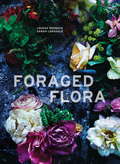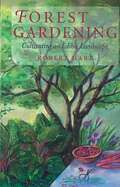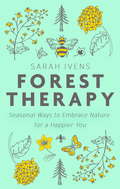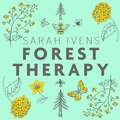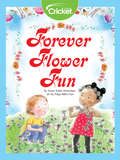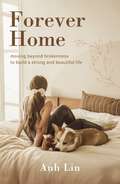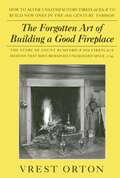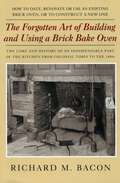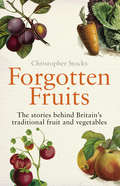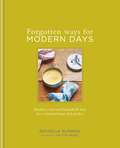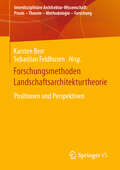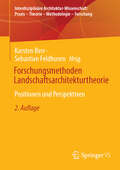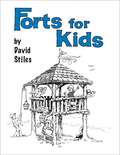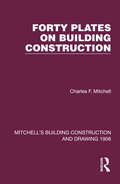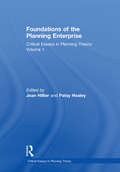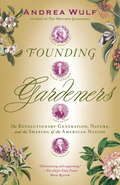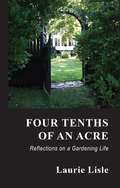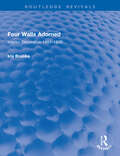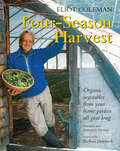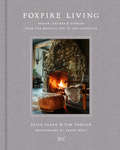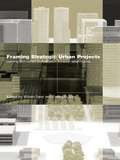- Table View
- List View
Foraged Flora: A Year of Gathering and Arranging Wild Plants and Flowers
by Laurie Frankel Sarah Lonsdale Louesa RoebuckA gorgeously photographed new take on flower arranging using local and foraged plants and flowers to create beautiful arrangements, with ideas and inspiration for the whole year.Roadside fennel, flowering fruit trees, garden roses, tiny violets; ingredients both common and unusual, humble and showy, Foraged Flora is a new vision for flowers and arranging. It encourages you to train your eye to the beauty that surrounds you, attune your senses to the seasonality and locality of flowers and plants, and to embrace the beauty in each stage of life, from first bud to withering seedpod. Organized by month, each chapter in this visually arresting and inspiring book focuses on large and small arrangements created from the flowers and plants available during that time period and in that place, all foraged or gleaned nearby. The authors reflect on surprising and beautiful pairings, the importance of scale, the scarcity or abundance of raw materials, and the environmental factors that contribute to that availability. Whether picking a small tendril of fragrant jasmine, collecting oversized branches of flowering quince, or making a garland of bay laurel, Foraged Flora is an invitation to seek out the beauty of the natural world.From the Hardcover edition.
Foreign Trends in American Gardens: A History of Exchange, Adaptation, and Reception
by Raffaella Fabiani GiannettoForeign Trends in American Gardens addresses the influence of foreign, designed landscapes on the development of their American counterparts. Including essays from an array of significant scholars in landscape studies, this collection examines topics ranging from the importation of Western and Eastern styles of design and theoretical literature to the adaptation of specific plant types. As the variety of topics and influences discussed demonstrates, the essence of American gardens defies simple definition. Examining the translation, imitation, adaptation, and naturalization of stylistic trends and horticultural specimens into American gardens, the book also dwells on the juxtaposition of the foreign and the native. The volume’s contributors consider the experiences both of immigrants, who contributed through their writing, planting, and design efforts to enhance the character of regional gardens, and of Americans, who traveled abroad and brought back with them a passion for naturalizing exotics for scientific as well as aesthetic reasons. The complexity of American gardens—their combination of the historic and the modern, and of foreign cultures and local values—is also their most distinctive characteristic.
Forest Gardening
by Robert Hart"Forest Gardening" is a way of working alongside nature--an approach that results in great productivity with minimal maintenance, and a method for transforming even a small cottage garden into a diverse and inviting habitat for songbirds, butterflies, and other wildlife. Based on the model of a natural woodland, a forest garden incorporates a wide variety of useful plants, including fruit and nut trees, perennial herbs, and vegetables. Hart's book beautifully describes his decades of experience gardening in the Shropshire countryside, yet the principles of "backyard permaculture" he explores can be applied equally well in other locales across the planet, from tropical to temperate zones. Practical features of the book include: bull; Design guidelines for creating your own perennial, food-producing garden bull; Lists of recommended plants and varieties, keyed to different climates bull; An explanation of how plants in different levels or "stories"--from ground covers to full-sized trees--coexist and interact in a healthy and productive landscape. Robert Hart blends history, philosophy, anthropology, and seasonal gardening wisdom in a lucid sequence of essays, which together comprise a remarkable testament to the pleasures of "hands-off" as well as hands-on gardening. "Forest Gardening" is truly a book for our times, offering a fresh sensibility that will encourage and inspire ecological gardeners throughout the world.
Forest Therapy: Seasonal Ways to Embrace Nature for a Happier You
by Sarah IvensWho hasn't felt better after a walk in the woods, a picnic alfresco or a swim in the sea? There is something soul-soothingly simple and refreshing about getting back to nature, about making the most of the great outdoors, being mindful of Mother Nature's gifts and grabbing spring and summer - and those blue sky, brisk days of autumn and winter - with both hands. But sadly it is a skill we are losing. We are becoming creatures wrapped in walls and trapped by to-do lists, hibernating while the world sprouts, grows and changes.From a simple walk in the woods and countryside couples therapy to DIY natural beauty products and how to bring the outdoors to your home, Forest Therapy will provide seasonal tips to help you reconnect with nature. This book is not just for mountain climbers or white water rafters - it is for uninspired fathers wanting to reconnect their families, bookworms looking to shake off their cobwebs, cooped-up kids needing to let off steam, stressed-out professionals wanting to stop and smell the flowers and worn-down mums needing a rejuvenating boost. We all know getting outside is good for us. Our ancestors did it. We should too. This book will help you live your most unforgettable, fabulous alfresco life.
Forest Therapy: Seasonal Ways to Embrace Nature for a Happier You
by Sarah IvensWho hasn't felt better after a walk in the woods, a picnic alfresco or a swim in the sea? There is something soul-soothingly simple and refreshing about getting back to nature, about making the most of the great outdoors, being mindful of Mother Nature's gifts and grabbing spring and summer - and those blue sky, brisk days of autumn and winter - with both hands. But sadly it is a skill we are losing. We are becoming creatures wrapped in walls and trapped by to-do lists, hibernating while the world sprouts, grows and changes.From a simple walk in the woods and countryside couples therapy to DIY natural beauty products and how to bring the outdoors to your home, Forest Therapy will provide seasonal tips to help you reconnect with nature. This book is not just for mountain climbers or white water rafters - it is for uninspired fathers wanting to reconnect their families, bookworms looking to shake off their cobwebs, cooped-up kids needing to let off steam, stressed-out professionals wanting to stop and smell the flowers and worn-down mums needing a rejuvenating boost. We all know getting outside is good for us. Our ancestors did it. We should too. This book will help you live your most unforgettable, fabulous alfresco life.
Forever Flower Fun
by Susan Yoder AckermanThere are so many fun things to do outside during the summer! When the flowers bloom, there is flower fun for everyone! When their hollyhock ladies and daisy chains wilt, Lily Rose and her friend learn how to preserve flowers by drying them. There's always an adventure in nature!
Forever Home: Moving Beyond Brokenness to Build a Strong and Beautiful Life
by Anh LinFrom the creator of The Abundant Life Devotional Journal and the popular YouTube channel Girl and The Word, Anh Lin's unique blend of biblical teaching and personal storytelling helps you build the strong, peaceful, abundant life you've always dreamed of--inside and out.Many of us long for lasting peace and stability, whether we are healing from painful memories, grieving a recent loss, or simply trying to find a quiet path in a chaotic world. In Forever Home, you can get to the root of "why does this keep happening to me?" by learning the truth behind your thoughts and the role they play in your current reality. As Anh vulnerably shares how she rebuilt her own "safe house" after the trauma of her early life, you will discover the five powerful steps to rebuilding your forever home:How to remove the unsafe patterns of your pastHow to renew the foundation of your lifeHow to rebuild the framework of your resilienceHow to reinforce the integrity of your boundariesHow to restore the beauty that God promised you It's time to uproot the things from your past, live free from the pain that's holding you back, and experience the abundant life that God designed just for you. Welcome home.
Forgotten Art of Building a Good Fireplace
by Vrest OrtonSince its original publication in 1969 by Yankee, Inc.,Vrest Orton's classic book on fireplace design has gone through numerous printings and has brought about a revival of the Rumford fireplace. The basic principles that Count Rumford set forth in 1795 describe the construction of a large shallow fireplace which does not smoke and which throws out much more heat than many of today's fireplaces which send too much of the heat up the chimney. This new edition contains some practical notes by Wally Leeds, a mason in Tunbridge,Vermont who builds Rumford fireplaces today.
Forgotten Art of Building and Using a Brick Bake Oven
by Richard M. BaconFirst published by Yankee Magazine in 1977, this book remains the authority on how old-time brick ovens were designed and used. The book explains the evolution of the brick oven from the 17th through the 19th centuries, out lines the basic points to consider in building such an oven today, and describes in detail construction of a brick oven, ash pit complex, including the tools required, procedures to be followed, types of brick and mortar, lintels and doors, plans, dimensions, and actual brickwork, graphically illustrated with photographs, diagrams and drawings. Also covered is how to heat and use such an oven, once built. Richard M. Bacon has written numerous articles for such publications as Yankee Magazine and the Sunday New York times. He also wrote The Yankee Book of Forgotten Arts, Simon & Schuster, 1978.
Forgotten Fruits: The stories behind Britain's traditional fruit and vegetables
by Christopher StocksIn Forgotten Fruits, Christopher Stocks tells the fascinating - often rather bizarre - stories behind Britain's rich heritage of fruit and vegetables. Take Newton Wonder apples, for instance, first discovered around 1870 allegedly growing in the thatch of a Derbyshire pub. Or the humble gooseberry which, among other things, helped Charles Darwin to arrive at his theory of evolution. Not to mention the ubiquitous tomato, introduced to Britain from South America in the sixteenth century but regarded as highly poisonous for hearly 200 years.This is a wonderful piece of social and natural history that will appeal to every gardener and food aficionado.
Forgotten Ways for Modern Days: Kitchen Cures And Household Lore For A Natural Home And Garden Foreward By Dottie Angel
by Rachelle BlondelForgotten Ways for Modern Days draws on the wisdom of the homemakers, gardeners, crafters and kitchen alchemists of the past who kept homes clean, gardens in order and hands busy using natural products and items found close to hand, either around the house or in the garden. Ingredients from kitchen cupboards, picked from the veg patch or foraged from hedgerows were used to clean clothes, cure a chesty cough and freshen the skin, whilst scraps of fabric were recycled in endless useful ways. With sections on Cleaning, Laundry, The Kitchen, In the Garden, Natural Health, and Beauty, Forgotten Ways for Modern Days brings this knowledge up to date and shares with the reader clever tips that make as much sense today, such as how to brighten your whites by putting eggshells in your wash. as well as an array of handy projects, including how to make Re-usable Beeswax Food Wrap, a Honey and Lemon Throat Soother and a Bits and Bobs Eiderdown.
Forgotten Ways for Modern Days: Kitchen cures and household lore for a natural home and garden Foreword by Dottie Angel
by Rachelle BlondelForgotten Ways for Modern Days draws on the wisdom of the homemakers, gardeners, crafters and kitchen alchemists of the past who kept homes clean, gardens in order and hands busy using natural products and items found close to hand, either around the house or in the garden. Ingredients from kitchen cupboards, picked from the veg patch or foraged from hedgerows were used to clean clothes, cure a chesty cough and freshen the skin, whilst scraps of fabric were recycled in endless useful ways. With sections on Cleaning, Laundry, The Kitchen, In the Garden, Natural Health, and Beauty, Forgotten Ways for Modern Days brings this knowledge up to date and shares with the reader clever tips that make as much sense today, such as how to brighten your whites by putting eggshells in your wash. as well as an array of handy projects, including how to make Re-usable Beeswax Food Wrap, a Honey and Lemon Throat Soother and a Bits and Bobs Eiderdown.
Forschungsmethoden Landschaftsarchitekturtheorie: Positionen und Perspektiven (Interdisziplinäre Architektur-Wissenschaft: Praxis – Theorie – Methodologie – Forschung)
by Karsten Berr Sebastian FeldhusenWie werden in Forschungsarbeiten in der Landschaftsarchitekturtheorie Erkenntnisse gewonnen? Um diese Frage zu beantworten, ist es sinnvoll, die Methode der Forschung einer individuellen Forschungsarbeit anschaulich zu machen. Ziel des Buchs ist es, eine Übersicht an aktuellen Forschungsmethoden im Feld der Landschaftsarchitekturtheorie zu geben. Damit möchte das Buch einen Beitrag zur Methodendiskussion in der Landschaftsarchitekturtheorie leisten, die häufig gefordert, aber selten geführt wird. Die Aufsätze in dem Buch sind untereinander formal und inhaltlich abgestimmt: Formal haben sie einen ähnlichen Aufbau, sodass die Methoden gut miteinander verglichen werden können. Inhaltlich sind die Aufsätze insofern miteinander abgestimmt, weil jeder Aufsatz für eine bestimmte Forschungsmethode in der Landschaftsarchitekturtheorie steht.
Forschungsmethoden Landschaftsarchitekturtheorie: Positionen und Perspektiven (Interdisziplinäre Architektur-Wissenschaft: Praxis – Theorie – Methodologie – Forschung)
by Karsten Berr Sebastian FeldhusenWie werden in Forschungsarbeiten in der Landschaftsarchitekturtheorie Erkenntnisse gewonnen? Um diese Frage zu beantworten, ist es sinnvoll, die Methode der Forschung einer individuellen Forschungsarbeit anschaulich zu machen. Ziel des Buchs ist es, eine Übersicht an aktuellen Forschungsmethoden im Feld der Landschaftsarchitekturtheorie zu geben. Damit möchte das Buch einen Beitrag zur Methodendiskussion in der Landschaftsarchitekturtheorie leisten, die häufig gefordert, aber selten geführt wird. Die Aufsätze in dem Buch sind untereinander formal und inhaltlich abgestimmt: Formal haben sie einen ähnlichen Aufbau, sodass die Methoden gut miteinander verglichen werden können. Inhaltlich sind die Aufsätze insofern miteinander abgestimmt, weil jeder Aufsatz für eine bestimmte Forschungsmethode in der Landschaftsarchitekturtheorie steht.
Forts for Kids
by David StilesA dreamer&’s handbook for kids—and parents—offering practical resultsAll kids love the idea of a hideaway—a place that is theirs, no parents allowed. But how on earth can they actually build one? In Forts for Kids, an inspirational yet practical guide, David Stiles, the most trusted authority on DIY building projects, shows them how.Assuming no previous experience from the fort builder, the book starts with the basics for kids and their parents: how to buy wood, and essential skills such as sawing and nailing. It includes a brief history of forts and more than twenty projects ranging from the simple (a blanket and umbrella fort) to the more challenging (a stockade fort). The book even includes forts made of snow, sand, or branches. An accessories section features projects that can be made in just a few hours, such as a slide, swing, catapult, periscope, cannon, and water balloon launcher.
Forty Plates on Building Construction: A Textbook on the Principles and Details of Modern Construction First Stage (Or Elementary Course) (Mitchell's Building Construction and Drawing #3)
by Charles F. MitchellOriginally published in 1891, this volume was a companion volume to the Elementary and Advanced volumes of Building Construction and Drawing. The exquisite technical drawings give a technical level of detail which is invaluable for the study of late 19th Century construction methods and materials and cover brickwork and masonry, carpentry, joinery, plumbing, roof and iron work.
Foundations of the Planning Enterprise: Critical Essays in Planning Theory: Volume 1 (Critical Essays in Planning Theory)
by Patsy HealeyPlanning Theory has a history of common debates about ideas and practices and is rooted in a critical concern for the 'improvement' of human and environmental well-being, particularly as pursued through interventions which seek to shape environmental conditions and place qualities.. The first volume in this three volume series, Foundations of the Planning Enterprise, includes articles and papers which offer a unique general introduction to planning theory. The authors review the subject's development, its recurrent themes, its contemporary preoccupation as rational scientific management and its relations to other fields. The editors supplement the collection with an introductory overview as well as detailed introductions to each part. This will be an essential purchase for planning libraries around the world.
Founding Gardeners: How the Revolutionary Generation Created an American Eden
by Andrea WulfFrom the author of the acclaimed The Brother Gardeners, a fascinating look at the founding fathers from the unique and intimate perspective of their lives as gardeners, plantsmen, and farmers. For the founding fathers, gardening, agriculture, and botany were elemental passions, as deeply ingrained in their characters as their belief in liberty for the nation they were creating. Andrea Wulf reveals for the first time this aspect of the revolutionary generation. She describes how, even as British ships gathered off Staten Island, George Washington wrote his estate manager about the garden at Mount Vernon; how a tour of English gardens renewed Thomas Jefferson's and John Adams's faith in their fledgling nation; how a trip to the great botanist John Bartram's garden helped the delegates of the Constitutional Congress break their deadlock; and why James Madison is the forgotten father of American environmentalism. These and other stories reveal a guiding but previously overlooked ideology of the American Revolution. Founding Gardeners adds depth and nuance to our understanding of the American experiment and provides us with a portrait of the founding fathers as they've never before been seen.
Four Tenths of an Acre
by Laurie LisleTwenty years ago, Laurie Lisle bought an old New England clapboard house with an awkwardly shaped backyard. As she worked to transform it into a graceful garden, she also found herself digging into her feelings about love and loss, work and play, roots and rootlessness, solitude and sociability. Now, in these intimate essays, Lisle explores the fascinating connections among one's interior landscape, village life, and the natural world.
Four Walls Adorned: Interior Decoration 1485–1820 (Routledge Revivals)
by Iris BrookeOriginally published in 1952, this book, profusely illustrated, describes the various styles of wall decoration that have been used in England from the time of Henry VII up to the reign of Queen Victoria. The houses illustrated are mainly the smaller English houses where economics of various sorts have been a greater factor in their original decoration than the actual fashions of the time. The ingenuity with which such contemporary fashion has been adapted to the smaller home makes a fascinating study. All forms of contemporary design are discussed: from the single panel and post partition wall of the late 15th century to the fascinating imitation of Classic and Oriental design in the 18th. The book closes with the Industrial Revolution when printed wall papers were manufactured for the millions and the craftsman was no longer required in the smaller home.
Four-Season Harvest: Organic Vegetables from Your Home Garden All Year Long, 2nd Edition
by Eliot Coleman&“Eliot is the reason I&’m cooking. . . . I&’ve followed that path because Eliot made it possible, and exciting, to farm in the four seasons.&”—Dan Barber, chef&“There is hardly a more well-known or well-respected name among organic farmers than Eliot Coleman.&”—Civil EatsLearn season-extending techniques and eat the best food—garden fresh and chemical free—all year long, with little effort or expense.If you love the joys of eating home-garden vegetables but always thought those joys had to stop at the end of summer, this book is for you. Eliot Coleman introduces the surprising fact that most of the United States has more winter sunshine than the south of France. He shows how North American gardeners can successfully use that sun to raise a wide variety of traditional winter vegetables in backyard cold frames and plastic covered tunnel greenhouses without supplementary heat.Inside, you&’ll also learn:Composting techniquesSimple Mineral AmendmentsPlanning and preparing your garden siteSeeds for four seasonsHow to build cold frames, high tunnels, and mobile greenhousesHow to cope with snowHow to create a root cellar and other storage techniquesAnd much, much more!Coleman expands upon his own experiences with new ideas learned on a winter-vegetable pilgrimage across the ocean to the acknowledged kingdom of vegetable cuisine, the southern part of France, which lies on the 44th parallel, the same latitude as his farm in Maine.This story of sunshine, weather patterns, old limitations and expectations, and new realities is delightfully innovative in the best gardening tradition. Four-Season Harvest will have you feasting on fresh produce from your garden all through the winter.&“The man, the farmer, the legend, is Eliot Coleman.&”—The AtlanticTo learn more about the possibility of a four-season farm, please visit Coleman&’s website www.fourseasonfarm.com.
Fox-Nahem: The Design Vision of Joe Nahem
by Anthony Iannacci Robert Downey&“Expertly curated and styled rooms . . . The fifteen standout projects featured . . . are a testament to Nahem&’s longstanding excellence and ingenuity.&” —Vanity Fair Foreword by Robert Downey Jr. Over thirty years, Joe Nahem of Fox-Nahem has built a reputation for creating classic, contemporary, bespoke, and highly creative interior designs. The first book on his career, Fox-Nahem presents his most luxurious, exuberant, and refined interiors that showcase his own personal vision of modernism. Featuring fifteen projects, the accompanying essays detail Nahem&’s design process, specifically his ability to function as much as a curator as designer, bringing together strong objects of quality and rarity in harmonious ensembles. Nahem&’s interiors are unique because he designs many of the finishes, textiles, and furnishings that establish the look and feel of a room. He calls on a stable of artisans and craftspeople, including woodworkers, metal workers, and weavers, who assist him in creating one-of-a-kind environments for clients who demand something that no one else has. With more than 250 photographs, Fox-Nahem celebrates the work of a designer who seamlessly adapts his style to suit the context and fit his clients&’ highly refined and original tastes.
Foxfire Living: Design, Recipes, and Stories from the Magical Inn in the Catskills
by Eliza Clark Tim TrojianA gorgeous full-color field guide to the innovative neo-vintage design style that is the hallmark of Foxfire Mountain House, the magical inn in the Catskills, bursting with design ideas, recipes, projects, and tips for achieving its dreamy aesthetic in your own home.When designer Eliza Clark and her chef husband Tim Trojian viewed the property that would eventually become the Foxfire Mountain House in Mount Tremper, New York, the real estate listing was for an adjacent cottage; the teetering remains of what had once been a popular Catskills hotel was thrown in as a bonus.Eliza and Tim set to work, radically redesigning the derelict property to create a relaxed bohemian retreat they called Foxfire Mountain House. The design and food of this transcendent inn is guided by nature, science, and curiosity, and informed by its rural location amid the bucolic mountains. The scenery is as much an element of Foxfire’s design as the color scheme; the inn’s old bones are complemented by unique vintage finds; and the meals are sourced from neighboring farms and local crops. Eliza and Tim’s eleven-room inn, cottage, and bar room/restaurant became an instant hit and a hot destination for urban dwellers looking for an escape in the country.Foxfire Living now brings the dreamy, rustic modern style that is the hallmark of this special place into any home. This lush guide is divided into chapters based on the phases of the day—Dawn, Morning, Day, Dusk, and Night—allowing you to move through each element of the inn’s design and renovation process in a natural and holistic way. Whether you want to completely redo your home or just make a few changes or additions, you’ll find thoughtful concepts and advice to guide you to:Discover—use the bones of your space to inform your design choicesGather—set up a design pantry and collect inspirationEvolve—allow yourself to stay open and curious as your design comes togetherReflect—enjoy what you’ve built and share it with othersIn telling the intriguing story of Foxfire’s rebirth, Eliza and Tim include thirty recipes and renovation projects that capture its spirit. Brimming with ethereal photos that are as full of wonder as the drive up the hill that leads to the inn, Foxfire Living is the story of paint colors, light fixtures, materials, and furnishings. But it is also about writing your own home’s story and creating a personal narrative that reflects your truest desires.
Fragmentary Forms: A New History of Collage
by Freya GowrleyA beautifully illustrated global history of collage from the origins of paper to todayWhile the emergence of collage is frequently placed in the twentieth century when it was a favored medium of modern artists, its earliest beginnings are tied to the invention of paper in China around 200 BCE. Subsequent forms occurred in twelfth-century Japan with illuminated manuscripts that combined calligraphic poetry with torn colored papers. In early modern Europe, collage was used to document and organize herbaria, plant specimens, and other systems of knowledge. In the eighteenth and nineteenth centuries, collage became firmly associated with the expression of intimate relations and familial affections. Fragmentary Forms offers a new, global perspective on one of the world&’s oldest and most enduring means of cultural expression, tracing the rich history of collage from its ancient origins to its uses today as a powerful tool for storytelling and explorations of identity.Presenting an expansive approach to collage and the history of art, Freya Gowrley explores what happens when overlapping fragmentary forms are in conversation with one another. She looks at everything from volumes of pilgrims&’ religious relics and Victorian seaweed albums to modernist papiers collés by Pablo Picasso and Georges Braque and quilts by Faith Ringgold exploring African-American identity. Gowrley examines the work of anonymous and unknown artists whose names have been lost to history, either by accident or through exclusion.Featuring hundreds of beautiful images, Fragmentary Forms demonstrates how the use of found objects is an important characteristic of this unique art form and shows how collage is an inclusive medium that has given voice to marginalized communities and artists across centuries and cultures.
Framing Strategic Urban Projects: Learning from current experiences in European urban regions
by Willem Salet Enrico GualiniPresenting the findings of extensive research into the development of planning tools and strategies since the early 1970s, this book addresses key issues in urban development/governance and brings together a range of different national experiences. Helpfully divided into three sections, Framing Strategic Urban Projects sets out the study framework, with its social, policy and institutional contexts; uses up-to-date European case studies to highlight different planning issues, including new-urbanism, information networks and public partnerships; and finally makes good-practice recommendations. Offering a systematic comparison of a wide variety of projects and providing useful case study material of these large-scale urban projects and recommendations, this book is essential reading for planners, policy makers and students interested in how to make strategic urban projects work effectively.
